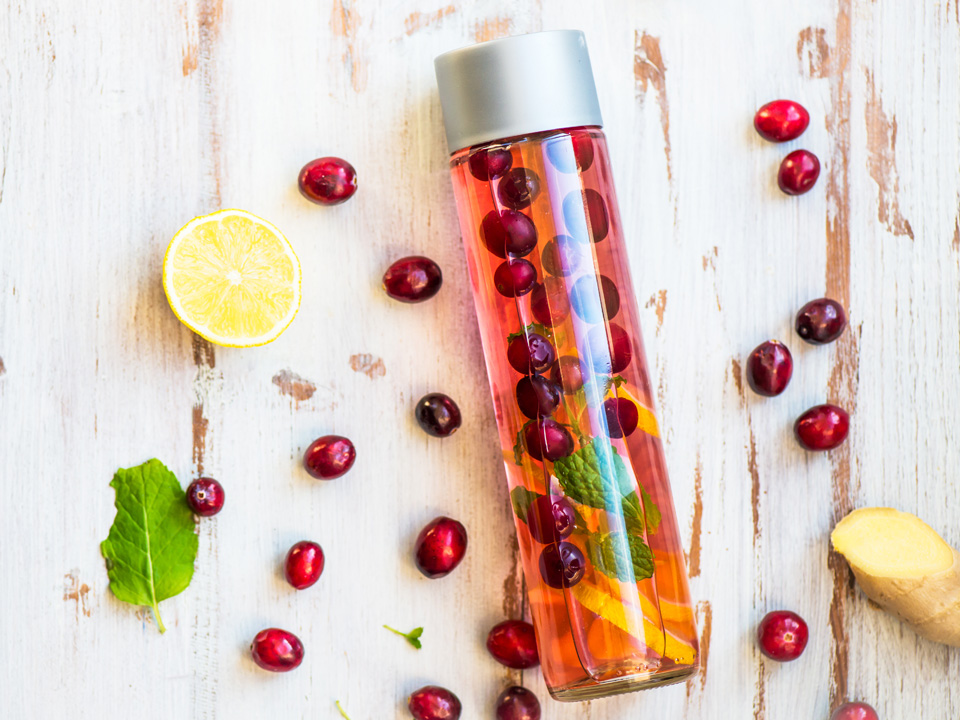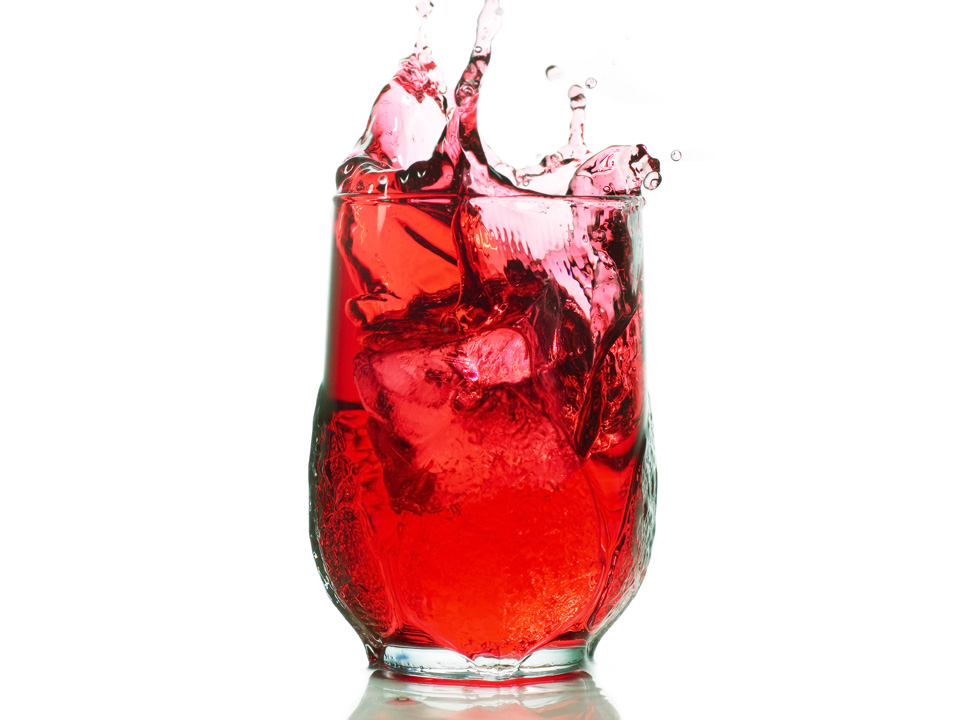
Cranberries

Benefits
Cranberries, a healthy choice
Cranberries were present in their wild state long before the arrival of the first European colonists in North America. They were a notable part of the American-Indian diet and were used to treat various health problems as well as being used as a preservative to conserve meat and fish.During the colonization period cranberries were used by the Europeans mainly to combat scurvy.
Nutritious properties
An excellent source of Vitamin C, cranberries are also excellent for bone health. This fruit is entirely void of sodium and contains very little sugar or protein. The daily consumption of 115 ml of fresh cranberries satisfies the daily need of Vitamin C for an adult.(Binet, M.et al.1997-Technical information journal on the ecological production of cranberries).
Nutrition Facts
| FRESH Cranberries ½ cup (125 ml or 50 g) | Amount | % Daily Value |
|---|---|---|
| Calories | 20 kcal | - |
| Carbohydrates | 6 g | - |
| Dietary fibre | 2 g | 7% |
| Sugars | 2 g | 2% |
| Potassium | 40 mg | 1% |
| Iron | 0.25 mg | 1% |
| Vitamin C | 7 mg | 8% |
| Manganese | 0.175 mg | 8% |
| DRIED Cranberries ¼ cup (60 ml or 31 g) | Amount | % Daily Value |
|---|---|---|
| Calories | 95 kcal | - |
| Carbohydrates | 25.3 g | - |
| Dietary fiber | 1.8 g | 6% |
| Vitamin C | 0.1 mg | 0% |
| Vitamin E | 0.33 mg | 2% |
| Manganese | 0.081 mg | 4% |
The anti-adhesive properties of cranberries have positive effects on:
- The urinary tract
- Ulcers
- Gums
- Dental plaque
The antioxidant properties of cranberries favor most notably:
- Cardiovascular health
- An increase in good cholesterol
Advantages
- Cranberries, also known as «atokas» or «red huckleberries» are considered a functional food.
According to the definition given by Health Canada, «A functional food is similar in appearance to, or may be a conventional food, is consumed as part of a usual diet, and is demonstrated to have physiological benefits and/or reduce the risk of chronic disease beyond basic nutritional functions.». - Cranberries may be eaten in many forms : fresh, dry, in sauce, in jam, in juice or in capsules
Combating urinary infections
Cranberries contain amazing infection-fighting properties, especially for fighting urinary tract infections in women. This is because cranberries contain a certain flavonoid that prevents bacteria from sticking to the lining of the urinary tract. Urinary tract infections (UTI) are among the most common bacterial infections. 25% of women suffer from recurring UTI. The E. colibacterium, which causes 80% to 90% of these infections, is becoming one of the most resistant to antibiotics. The latest research shows that the antibiotic compounds found in cranberries are effective against 80% of bacteria resistant to antibiotics.

Fighting infection
A regular intake of cranberry products may reduce the risk of recurring infections by up to 40% and in turn, reduce the need for antibiotic treatment.
In fact, cranberries contain a unique type of anatural substance called proanthocyanidin which, in a similar way to antibiotics, prevents the adherence of infection-causing bacteria to the urethra, the intestines or the gums. A recent study showed that the anti-adhesion effects from a glass of cranberry juice begin to take effect just two hours after consumption and may last for up to ten hours. The harmful bacteria cannot develop and continue to cause infection. Apple juice, grape juice, green tea and chocolate, all which contain another type of proanthocyanidin, show little or no anti-adhesion activity.
Preventing intestinal diseases
The H.pyloribacterium is responsible for 80 to 90% of stomach and intestinal ulcers. Two-thirds of the population world-wide is affected by these bacteria, most during their early childhood. According to certain studies, cranberry juice prevents this organism from developing in the body and shows a 9% reduction in the rate of infection.
Assuring dental health
The basic dental cavity is the more common infectious disease on the planet, touching 90% of the population world-wide. Laboratory studies how that cranberry juice extracts can prevent the adhesion and growth of bacteria causing dental plaque. Furthermore, clinical studies report that cranberry mouth-wash reduced the presence of harmful bacteria in saliva.
By hindering the adhesion and growth of bacteria, reducing the destruction of gum tissue and diminishing swelling, the properties in this tiny red berry are becoming interesting for the treatment of periodontal disease, a gum disease that affects nearly 75% of the population.
Neutralizing free radicals
Rich in flavonoids, cranberries outshine over a dozen other fruits due tot heir antioxidant capacity. They are renown by scientists for the amount of phenolic compounds they possess, thereby classifying the cranberry among fruits which permit the neutralization of free radicals (instable molecules) in the body hence preventing certain types of cardiovascular and cancerous diseases.
Flavonoids found in cranberries
- Anthocyanines
- Flavones, especially catechins
- Flavones
- Tannins or flavones, notably proanthocyanidins and quercetins
Everyday, the cells in our bodies use many billions of molecules of oxygen to burn calories and produce energy. A small part of this oxygen however escapes combustion and succeeds in generating free radicals by oxidization. When these oxidized molecules are not neutralized or eliminated from the body by a natural antioxidant mechanism, they accumulate and destroy the cell membrane and DNA protein in a similar way to rust on an automobile. The cells then suffer oxidative stress which is the origin to the aging process in the human body, cardiovascular diseases, cancer and other health issues. It is therefore of utmost importance to nourish one's self with antioxidants in order to fight free radicals!
Many scientific studies document the benefits of cranberry health.
For more information, visit the following websites:
Documents or articles are in the original language and are not available in other languages.
- Les bienfaits de la canneberge, Radio-Canada : Bien dans son assiette (29-07-2013) [Listen]
Nathalie Tufenkji , chercheuse du Département de génie chimique de l'Université McGill - The Cranberry Institute is a nonprofit organization which focuses on the scientific study of cranberries and their therapeutic properties: [Visit website]
- Cranberry Marketing Committee (CMC) a été établi en tant qu'Office fédéral de commercialisation pour assurer un approvisionnement stable et ordonné en produits de bonne qualité. [Visit website]
- PasseportSanté.net [Visit website]
- Wisconsin State Cranberry Growers Association [Visit website]
- Top santé [Visit website]
- La canneberge : Le dentifrice de demain (01-01-2008) [Visit website]
- Les polyphénols de la canneberge : Effets bénéfiques potentiels contre la carie dentaire et la maladie parodontale (French only) [288 Ko]
